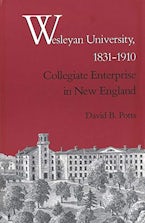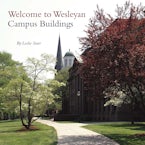
Wesleyan University, 1910–1970
Academic Ambition and Middle-Class America
Sales Date: 2015-05-11
A lively and probing analysis of the development of twentieth-century liberal education
Winner of the Homer D. Babbidge Jr. (2016)
In Wesleyan University, 1910–1970, David B. Potts presents an engaging story that includes a measured departure from denominational identity, an enterprising acquisition of fabulous wealth, and a burst of enthusiastic aspirations that initiated an era of financial stress. Threaded through these episodes is a commitment to social service that is rooted in Methodism and clothed in more humanistic garb after World War II.
Potts gives an unprecedented level of attention to the board of trustees and finances. These closely related components are now clearly introduced as major shaping forces in the development of American higher education. Extensive examination is also given to student and faculty roles in building and altering institutional identity. Threaded throughout these probes within in the analytical narrative is a close look at the waxing and waning of presidential leadership.
All these developments, as is particularly evident in the areas of student demography and faculty compensation, travel on a pathway through middle-class America. Within this broad context, Wesleyan becomes a window on how the nation's liberal arts colleges survived and thrived during the last century.
This book concludes the author's analysis of changes in institutional identities that shaped the narrative for his widely praised first volume, Wesleyan University, 1831–1910: Collegiate Enterprise in New England. His current fully evidenced sequel supplies helpful insights and reference points as we encounter the present fiscal strain in higher education and the related debates on institutional mission.
Illustrations
Preface
Acknowledgments
Introduction
Fisher and Fiduciaries
On the Road to Recognition
Membership in the Little Three
Holding Ground in Hard Times
War as an Agent of Change
"A New Major American University"
Hazards of New Fortune
Appendix 1: Presidencies, 1831 to present
Appendix 2: Enrollments at Wesleyan, Amherst, and Williams, 1910-1990
Appendix 3: Endowment Dollars Per Student at Wesleyan, Amherst, and Williams, 1930-1990
Abbreviations Used in Notes
Notes
Index of First Citations Used in Notes
Index of Subjects
Index of Persons
DAVID B. POTTS is an independent historian and consultant on historical resources for higher education. His prior books include Liberal Education for a Land of Colleges: Yale's Reports of 1828 and Baptist Colleges in the Development of American Society, 1812–1861. He lives in Tacoma, Washington.
"David Potts's account of the history of Wesleyan University between 1910 and 1970 covers these sixty years thoroughly with an impressive mix of exhaustive research and first-rate storytelling ... On many issues, this volume does an excellent job of not only telling the story of Wesleyan's history but of using that history to illuminate larger issues in the history of higher education."
~James W. Fraser, New England Quarterly
""Upon removing this book from its mailing envelope, the reviewer immediately recognized a substantial work was at hand. A complete read did not disappoint Potts' experience of all aspects of university life—student, instructor, researcher, and administrator—provides an excellent basis for his impressive dealing with finances and the role of trustees in the operation of an institution of higher education Wesleyan could not ask for a better portrait of this important part of its history.""
~Bruce M. Stave, Connecticut History Review
""Wesleyan University. 1910-1970 traces Wesleyan's rise from regional college to top-ranking national institution, one that truly merits the appellation 'university.' David Potts (PhD'67, history of American civilization) has produced a work of meticulous scholarship, mot a warm-and-cuddly alumni-relations project. He closely examines the university's fundraising, its expanding academic programs, and its sometimes uneasy adjustment to a more diverse student body.""
~James Clyde Sellman, Colloquy
""David Potts's account of the history of Wesleyan University between 1910 and 1970 covers these sixty years thoroughly with an impressive mix of exhaustive research and first-rate storytelling On many issues, this volume does an excellent job of not only telling the story of Wesleyan's history but of using that history to illuminate larger issues in the history of higher education.""
~James W. Fraser, New England Quarterly
""[A] gripping account of the struggle to realize such an ideal [what a liberal arts college should be] and the ways in which professors, students, administrators, trustees, and alumni pulled it in different directions.""
~Andrea L. Turpin, Reviews in American History
"David Potts's first volume on Wesleyan history was a major achievement not just in academic history but in social history more broadly conceived. This one is even better. It fulfills the highest aspirations for any historian of any social institution."
~Hugh Hawkins, Anson D. Morse Professor of History and American Studies Emeritus, Amherst College
"An outstanding institution of higher education such as Wesleyan University deserves an outstanding institutional history, and David Potts has written just that. This is scholarship at its very best.""
~David M. Stameshkin, author of The Strength of the Hills: Middlebury College, 1915–1990
"This superb follow-on to Potts's first volume on the history of Wesleyan University maintains the exceptional quality of its predecessor. College histories tend to puffery, but this one is a solid, critical and knowledgeable account. Potts here establishes himself as one of the finest historians of higher education, and Wesleyan gets the sort of history a great institution deserves.""
~Stanley N. Katz, lecturer/professor, Woodrow Wilson School, Princeton University



